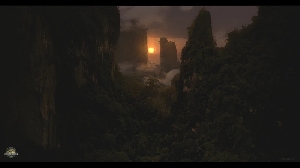A comparison of the Big Four
Dinosaurs Forum Topic

Carnosaur
MemberCompsognathusMarch 15, 2014Locked5846 Views37 RepliesA scientific look at the largest of the large
Carcharodontosaurus Saharicus
"The shark toothed lizard"

Carcharodontosaurus is included some of the longest and heaviest known carnivorous dinosaurs, The Carcharodontosauridae. . These animals are amongst the most sucessful land carnivores of all time, and this lead to immense size in a few species.There are two recognized species: C. Iguedensis, and the far better known C. Saharicus.
Various scientists proposing length estimates for the species C. saharicus ranging between 12 and 13 m (39 and 43 ft) and weight estimates between 6 and 15 tons. Most paleontologists put this animal at 13 meters and 8 tons.
Carcharodontosaurus had enormous jaws and long, serrated teeth up to eight inches long.Paleontologist sonce thought that Carcharodontosaurus had the longest skulls of any of the Theropod dinosaurs. However, the premaxila and quadrate bones were missing from the original African skull, which led to an over estimation of its actual size by researchers. A more modest length of 1.6 meters (5.2 ft) has now been proposed for C. saharicus, and the skull of C. iguidensis is reported to have been about the same size. (1.4 meters; 5 feet). Currently, the largest known theropod skull belongs to another huge carcharodontosaurid, the closely related Giganotosaurus whos skull length estimated at up to 1.95 m (6.3 ft.)
Spinosaurus Aegyptiacus
"The Spine lizard"

Since its discovery, Spinosaurus has been a contender for the longest and largest theropod dinosaur. In 1988, Gregory Paul also listed it as the longest theropod at 15 meters (49 ft), but gave a low mass estimate of 4 tons.
Dal Sasso et al. (2005) assumed that Spinosaurus and Suchomimus had the same body proportions in relation to their skull lengths, and thereby calculated that Spinosaurus was 16 to 18 meters (52 to 59 ft) in length and 7 to 9 tons. The Dal Sasso et al. estimates were criticized because the skull length estimate was uncertain, and (assuming thatbody mass increases as the cube of body length) scaling Suchomimus which was 11 meters (36 ft) long and 3.8 tonnes (4.2 short tons) in mass to the range of estimated lengths of Spinosaurus would produce an estimated body mass of 11.7 to 16.7 tons.
Therrien and Henderson(2007) used scaling based on skull length, challenged previous estimates of the size of Spinosaurus, finding the length too great and the weight too small. Based on estimated skull lengths of 1.5 to 1.75 meters (4.9 to 5.7 ft), their estimates include a body length of 12.6 to 14.3 meters (41 to 47 ft) and a body mass of 12 to 20.9 tonnes (11.8 to 20.6 long tons; 13.2 to 23.0 short tons). The lower estimates for Spinosaurus would imply that the animal was shorter and lighter than Carcharodontosaurus and Giganotosaurus. The Therrien and Henderson study has been criticized for the choice of theropods used for comparison (Carnosaurs in particular) There are few remains that have been uncovered of Spinosaurus, and without those remains, a widely accepted scientific size range is impossible.
Tyrannosaurus Rex
"The tyrant lizard king"

Tyrannosaurus rex was one of the largest land carnivores of all time; the largest complete specimen, FMNH PR2081 ("Sue") measured 12.3 metres (40 ft) long and was 4 metres (13 ft) tall at the hips. Mass estimates have varied widely over the years, from more than 7.9 tons to less than 4.5 tons with most modern estimates ranging between 6.0 and 6.8 tons. Packard et al. (2009) tested dinosaur mass estimation procedures on elephants and concluded that dinosaur estimations are flawed and produce over-estimations; thus, the weight of Tyrannosaurus could have been much less than usually estimated. Other estimations have concluded that the largest known Tyrannosaurus specimens had masses approaching 9 tons. A recent study conducted factored in things such as organ and blood weight, making the Tyrannosaurus even more immense. This can be applied to all theropods however, and it seems we may have new weights for most large theropods in the near future. There are legends of huge Tyrannosaurus specimens, Particularly C. Rex, F.Rex, Mor 008. These animals are far too fragmentary to even establish a size, as bone size of Tyrannosaurusseem to vary between invididuals.
Giganotosaurus Carolinii
"The giant southern lizard"
 The skull of Giganotosaurus is large; that of the holotype was in 1995 estimated at 1.53 m (5.0 ft) in length. Even though the original authors briefly claimed the length to be up to 1.8 m (5.9 ft)—leading to an estimate of 1.95 m (6.4 ft) skull length for the referred specimen—this claim was not repeated by subsequent workers and one of the original authors was in 2002 co-writer of an article giving a holotype skull length of 1.6 meters (5.2 ft)t. The back of the skull as preserved is strongly inclined forwards, bringing the jaw joints far behind the attachment point, enacting the jaws a type of scissors, capable of slicing off large chunks of flesh. A large individual, (MUCPv-95) os not nearly as complete - around 8% -. Estimates have put this animal at around 15 meters, but like spinosaurus, more remains would need to be dug up to confirm Giganotosaurus' star status.
The skull of Giganotosaurus is large; that of the holotype was in 1995 estimated at 1.53 m (5.0 ft) in length. Even though the original authors briefly claimed the length to be up to 1.8 m (5.9 ft)—leading to an estimate of 1.95 m (6.4 ft) skull length for the referred specimen—this claim was not repeated by subsequent workers and one of the original authors was in 2002 co-writer of an article giving a holotype skull length of 1.6 meters (5.2 ft)t. The back of the skull as preserved is strongly inclined forwards, bringing the jaw joints far behind the attachment point, enacting the jaws a type of scissors, capable of slicing off large chunks of flesh. A large individual, (MUCPv-95) os not nearly as complete - around 8% -. Estimates have put this animal at around 15 meters, but like spinosaurus, more remains would need to be dug up to confirm Giganotosaurus' star status.
The total length of the holotype has been estimated between 12.2 and 12.5 m (40 and 41 the largest specimen is 13.2 m (43 ft), and the weight between 6.5 and 13.8 tons. Most paleontologists put it at a conservative 12 meters and 7 tons, slightly smaller then C. Saharicus.
So, where does this leave us?
Largest theropod: Tyrannosaurus/ Carcharodontosaurus
Longest Theropod: Spinosaurus
Longest skull: Giganotosaurus
Most powerful bite force: Tyrannosaurus
Tallest Theropod: Spinosaurus(?)
Nature doesn't deceive us; it is we who deceive ourselves.



















